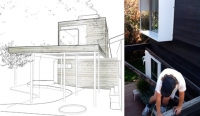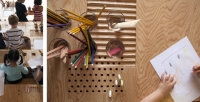Iris Anna Regn and Tim Durfee
Here Iris and Tim share thoughts on their own soon to be expanded home. For Iris and Tim – aided by an open, thoughtful design, and imbued with their combined intelligence - this home is where a central aspect of their work will be woven into the fabric of their lives.
#1 (see below)
Work, space, some practicalities: we are more interested in how work happens in places than in “places for work.”
We both have multi-disciplinary, collaborative design practices and often work together. We live in a small cabin of a house in Los Angeles with one child, one cat, a Mini, and a dwarf hamster. At home we share a desk located in front of a big window from which we can watch our daughter and her friends play on two tree-swings.
#2 (see below)
In our future house we hope to build on this small example of telescoping space: where the different parts are simultaneously visible, welcoming different modes of living.
#3 (see below)
Over-easy house, DurfeeRegn
Iris: I have always admired the way Marguerite Duras worked – stolen spaces in her living room, or in a simple sunny nook. Having work areas in various locations of the house, somewhat defined (by Duras as stacks of books and ashtrays), allows for the different functions and humors.
Duras writes: “There are houses that are too well made, too well thought out, completely without surprises, devised in advance by experts. By surprise I mean the unpredictable element produced by the way a house is used…” (Practicalities: Marguerite Duras Speaks to Jerome Beaujour, Grove/Atlantic, Inc, 1993)
#4 (see below)
Some situations engender productive improvisation. “Misused” programmed spaces, leftover or residual spaces, selective ambiguous specificity
Iris: When our daughter was an infant we took her to R.I.E. parenting classes, where we learned about open-ended play. Encountering this idea as the result of serious developmental research lent new conviction to thoughts we had about spaces which allow occupants to define their own desires.
Tim: I believe the best architecture balances the use of somewhat abstract, objective systems with subjective specificity. To consider a place for working is equally a process of structuring an environment with an optimistic potential for use, and a somewhat intuitive referencing of places I have experienced. For me, “live/work” inescapably conjures an adolescent memory of the fake wood-paneled basement room we called the “library,” where all of the books not worthy of the living room were shelved: I’m OK, You’re OK, The Amazing Mrs. Polifax. I wrote term papers to the sound of the freestanding dehumidifier periodically shuddering on, pulling gallons of water from the summer air.
#5 (see below)
Duras: “… most modern houses… don’t have passages… for children to play and run about in, and for dogs, umbrellas, coats and satchels…passages and corridors are where the young go when they’re four years old and have had enough of grownups and their philosophy.“
#6 (see below)
Rather than being an idle “deck,” an outdoor space could be on its way somewhere. hood-House, DurfeeRegn
At times merely the appearance of utility can be comforting, and inspiring – even when it is not clear exactly what the purpose of a space or object might be. We think of it as a kind of selective or layered specificity that encourages thought, participation, and sometimes even community.
#7 (see below)
Growth Table, DurfeeRegn. Photographs: Matt Shodorf
Tim: Kitchens in particular, have this quality – they are the most purposeful-looking of domestic spaces, and can lend a certain focus to tasks that have nothing to do with food. A kitchen makes for an excellent place to pay bills, as though the responsible management of money is assured in the location where the food is kept and prepared. As a teenager in Brussels I built model airplanes and plastic Big Daddy Roth hot-rods in a tiny kitchen on the third floor of our house. I sat on a high stool, which afforded a view through a single, small window. The gray patter of low-country drizzle, David Bowie on auto-rewind.








